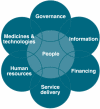A research agenda for malaria eradication: health systems and operational research
- PMID: 21311588
- PMCID: PMC3026705
- DOI: 10.1371/journal.pmed.1000397
A research agenda for malaria eradication: health systems and operational research
Abstract
Health systems research and development is needed to support the global malaria eradication agenda. In this paper, we (the malERA Consultative Group on Health Systems and Operational Research) focus on the health systems needs of the elimination phase of malaria eradication and consider groupings of countries at different stages along the pathway to elimination. We examine the difference between the last attempt at eradication of malaria and more recent initiatives, and consider the changing health system challenges as countries make progress towards elimination. We review recent technological and theoretical developments related to health systems and the renewed commitment to strengthening health systems for universal access and greater equity. Finally, we identify a number of needs for research and development, including tools for analyzing and improving effective coverage and strengthening decision making and discuss the relevance of these needs at all levels of the health system from the community to the international level.
Conflict of interest statement
The authors have declared that they have no competing interests.
Figures


References
-
- Gramicci G, Beales PF. The recent history of malaria control and eradication. In: Wernsdorfer WH, McGregor SI, editors. Principles and practice of malariology. Edinburgh: Churchill Livingstone; 1988. pp. 1335–1420.
-
- Nájera JA. Malaria control: Achievements, problems and strategies. Parassitologia. 2001;43:1–89. - PubMed
-
- Dowdle WR, Hopkins DR, editors. Chichester: John Wiley & Sons; 1997. The eradication of infectious diseases, Dahlem Workshop Report.
-
- WHO. Geneva: World Health Organization; 2000. World health report 2000 – Health systems: Improving performance.
-
- WHO. Geneva: World Health Organization; 2007. Everybody's business: Strengthening health systems to improve health outcomes: WHO's Framework for Action.
Publication types
MeSH terms
LinkOut - more resources
Full Text Sources
Medical

